
Let’s be honest: most B2B blog content is sub-par.
And if you’re wondering why the average post leaves a lot to be desired, there is no “right” answer.
Maybe it was put together by someone in-house who considers themselves a sales or marketing expert but not much of a wordsmith.
Or perhaps it was written in a rush without long-term promotion, optimization or readability in mind.
Either way, there’s a lot of noise out there.
Note that a staggering 91% of content receives no traffic from Google. Most content similarly receives few to no shares on social media.
But hey, all of that noise represents a huge window of opportunity if you’re a B2B blogger looking to rank for more keywords on behalf of your company or clients.
6 telltale signs of beatable B2B blog content
Before we get into the good stuff, keep in mind Google’s infamous ~200 ranking factors that influence your content’s position in the SERPs.
Translation? Content alone isn’t going to guarantee your ability to outrank a competing post. Factors such as backlinks and domain authority are still very much in play.
That said, most SEO experts cite content quality, depth and “freshness” as among the most important ranking factors.
And if you’re a writer, these key content-related factors are totally in your control.
But how do you identify B2B blog content that’s beatable?
For starters, I’d recommend a quick Google search for terms you’re interested in ranking for.
Supplemented by free keyword tools like SEMrush or Moz, you can get a good idea of who’s ranking and what your competitors’ average blog posts look like.
Then, be on the lookout for the following six indicators of “thin” content and blogs you can outrank.
1. No original images or embeds
If you spot a B2B blog post with absolutely no images on Google’s front page, you’ve potentially struck gold.
Why?
For starters, imageless blog posts are often the sort of content that’s been farmed out to content mills (think: Upwork, iWriter and so on).
Content mill writers are focused on pumping out as many posts as possible. Their posts represent the absolutely bare minimum requirements of quality, readability or originality to get paid (and hopefully not get penalized by Google).
This is the exact sort of content you’re looking to crush.
According to a recent study by Bannersnack and Orbit Media, most bloggers include multiple images in any given post.
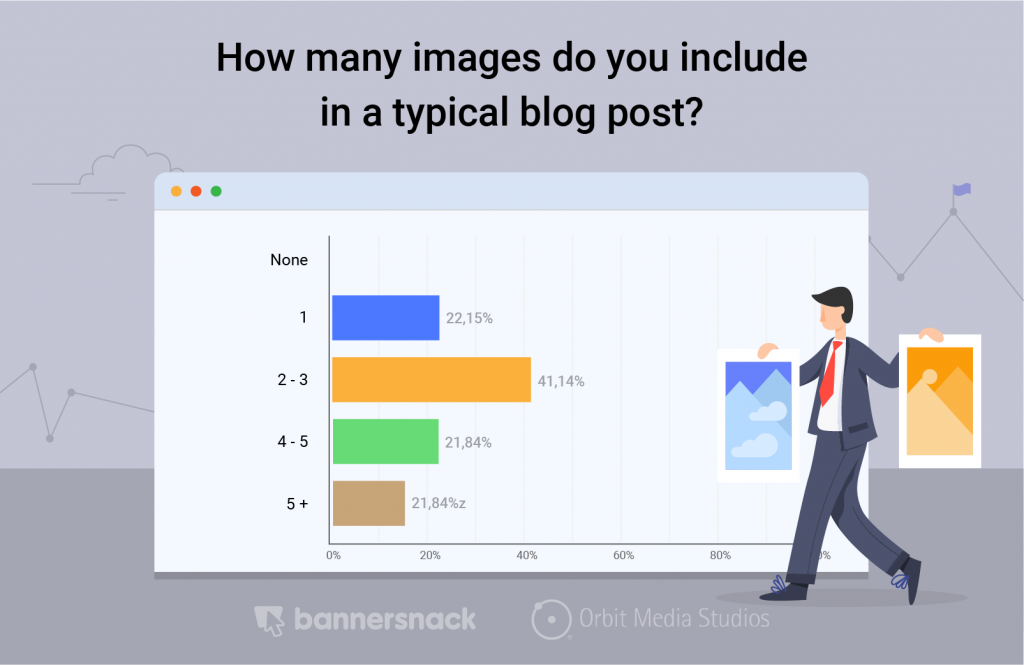
Why, though?
Because including original images (think: screenshots, not stock photos) and embeds throughout blog posts is essential for both UX and readability.
Doing so not only breaks up your content but also helps you illustrate your points.
Without images or examples, you don’t have any sort of “meat.”
If nothing else, the correlation between visual content and better search rankings is also well-documented. There are plenty of opportunities to optimize images for SEO which further signals the value of including images in your content.
And if you’re writing for B2B, you have plenty of options in terms of imagery.
Graphs. Screenshots of tools. Tweets from executives. The list goes on.
Anecdotally, I try to make my own client content as example-heavy as possible. Based on my own portfolio and what I’ve seen from clients and competitors, B2B blog content that ranks is typically brimming with images and real-life digital marketing examples.
2. Walls of text with few paragraph breaks
This is somewhat related to the previous point but deserves its own mention.
Below is an example of a keyword-stuffed mess that I put together over a decade ago as a content writing intern.
You don’t even have to read it. Just look at it.
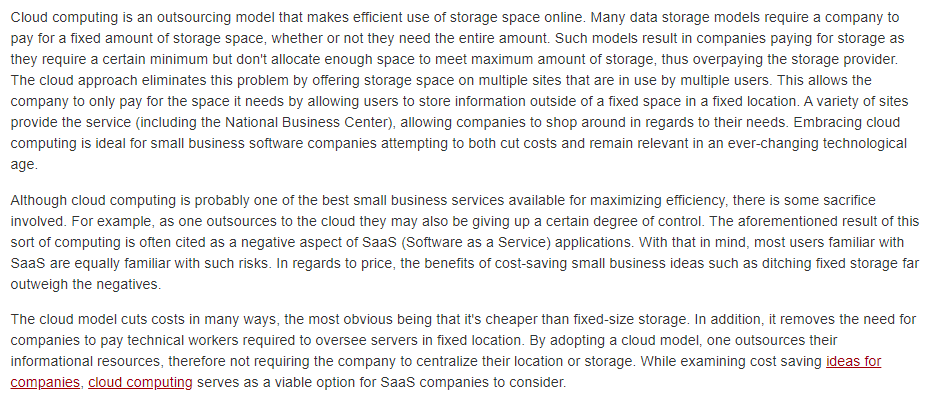
Beyond the fact that the writing itself is awful, the blocky paragraphs make this so-called “post” pretty much unreadable. If I landed on an article that looked like that in 2020, I’d immediately look elsewhere for answers.
That said, I still see B2B blog content that looks eerily similar to junk SEO articles from 2010.
Avoiding walls of text and blocky paragraphs is stupidly simple, but easy to overlook.
The rule of thumb for modern content writers is to keep paragraphs to just two or three sentences.
Although some critics might lampoon the overuse of single-sentence “paragraphs” (and rightfully so), such posts are definitely easier to read than a five-to-seven sentence slog. Simply put, shorter paragraphs make it easier to hold your readers’ attention and move from point to point.
Breaking up your content this way might take some getting used to and definitely contradicts what you learned in high school or college. That said, it’s the norm for B2B blog content.
3. No keywords present in titles, subheaders or meta descriptions
Keywords aren’t everything when it comes to B2B blog content, but a lack of ’em can help you identify posts that aren’t optimized for SEO.
If you spot a post that doesn’t have keyword-optimized titles or subheaders (think: h2, h3), that’s a good sign for you.
Of course, posts can still rank without optimized titles and headers. The importance of such factors is sometimes overemphasized by folks writing for SEO, too.
That said, these are simple acts of optimization that can likewise make your posts friendlier for readers. Frequent subheaders naturally make for more scannable content, for example.
And if you’re writing a long-form blog post, you’re more than likely going to need to break up your content with subheaders as you cover multiple topics in the same piece.
For example, this post from WPBeginner scores Google’s featured snipped for “email marketing tools” and tackles a ton of relevant keywords via subheaders in the process.
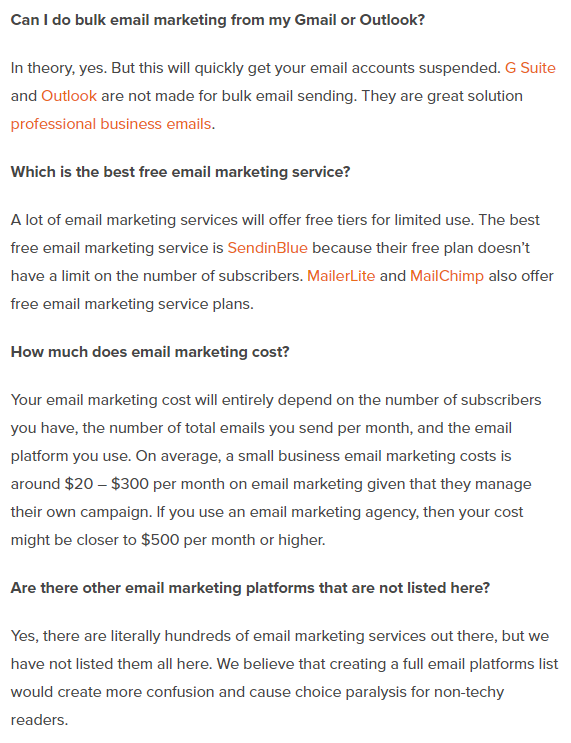
Keywords are less pressing for meta descriptions, but seeing bold, exact-match terms in search signals that whatever you’ve written satisfies your searcher’s intent.
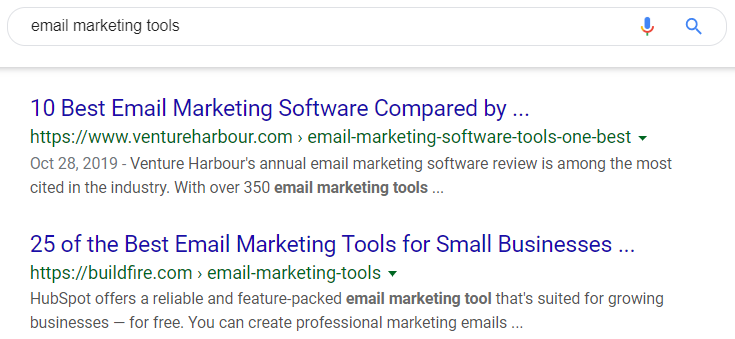
Besides, writing write meta descriptions only takes a minute or so. If someone isn’t taking the time to include keywords in theirs, they probably aren’t too worried about optimizing their B2B blog content for SEO.
4. Low word count (~500 – 700 words)
No surprises here.
Conventional wisdom tells us that long-form content almost always outperforms shorter, bite-sized blog posts.
It’s easy to identify thin, low-effort posts at a glance, too.
This is especially true in the case of B2B content which often lends itself to long-form pieces.
For example, a post on “content marketing tips” or “how to promote a blog post” could easily be in the 3,000-word range. Such topics could honestly be full-blown e-books.
Not everything you write needs to be considered “skyscraper content.” That said, there’s a reason why most high-ranking B2B blog posts are at least 1,500 words.
For starters, consider Google’s desire to see content that exemplifies “E-A-T” (expertise, authority, trustworthiness).
Roll your eyes at the acronym, but the sentiment remains the same. Unless you’re covering a very specific or technical topic, it’s hard to show off your expertise or authority in a couple of hundred words.
And of course, there’s data that backs up the SEO power of long-form content. Recent research by CanIRank highlights how higher word counts correlate with better rankings.
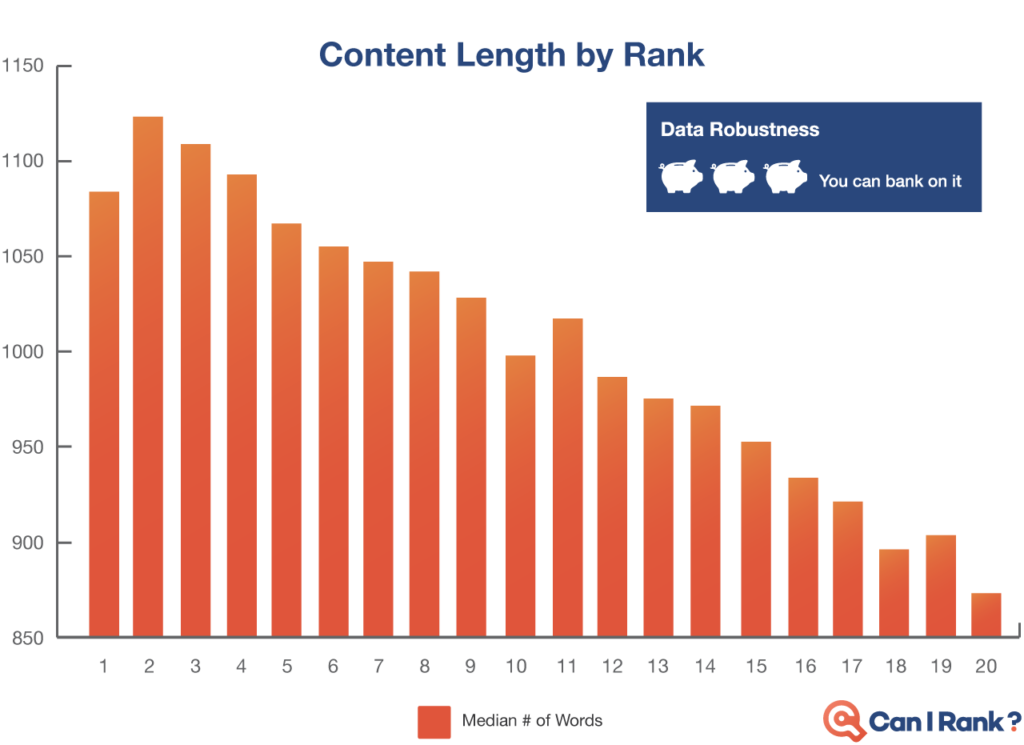
Meanwhile, recent data from Orbit Media helps drive this point home.
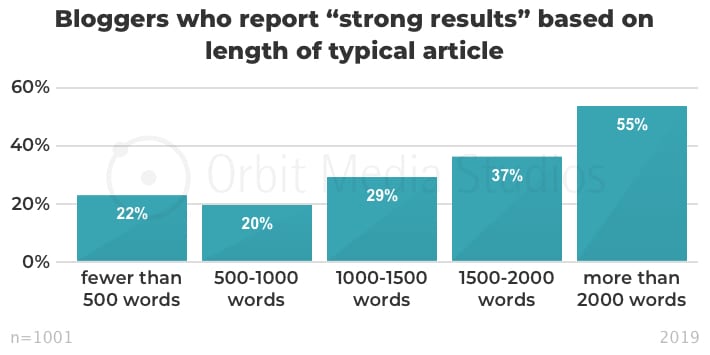
So many blog posts represent the bare minimum in terms of word count. Ideally, your B2B blog content strategy should be based around longer-form content.
If someone is tied to length recommendations from somewhere like Yoast who recommend just a few hundred words, chances are you can write something more meaningful and in-depth.
5. Outdated posts (three or more years-old)
As noted earlier, “freshness” is considered a critical factor for search rankings.
Bear in mind that the majority of older B2B blog posts that rank well represent evergreen content. These posts could probably benefit from a light refresh, but they’ve likely been gathering links for years and therefore have staying power.
But if you’re writing about tips, tactics and advice for folks in B2B, anything that’s a few years old is more than likely outdated.
For example, a post about social media tips recommending the use of Google+ (which shut down in 2019) isn’t relevant to readers today. Such details instantly tell the reader that the post isn’t up-to-date.
Timeless matters because the B2B space is crazy consistently evolving.
Tools come and go. Companies, too. Best practices change. There are always new statistics and studies coming out which can make any given piece of content more timely.
In the case of most B2B blog content, high-ranking posts are time-sensitive. Note that the top results for “marketing statistics” are dated for 2020 or were written within the past couple of months (as of writing this post).
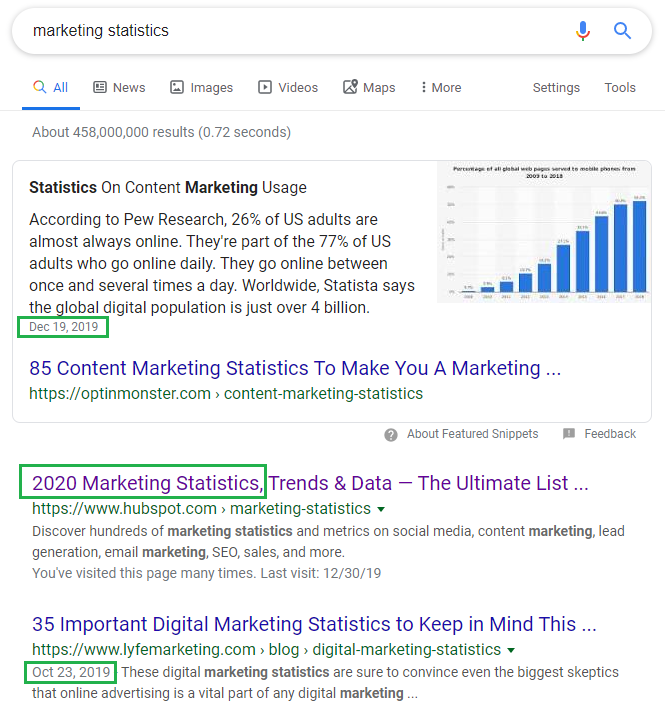
If you see a non-evergreen post that’s a few years old, consider how you can create a new piece that can outrank it by virtue of being timelier.
6. Lack of name recognition or domain authority
I debated whether or not to mention this last point, but let’s dive into it.
Just because you don’t recognize a site or company that’s ranking for a keyword doesn’t mean that they’re small-time.
That said, a site without name recognition ranking well probably means that you stand a fighting chance if you’re a smaller site or solo B2B writer yourself.
As I said earlier, factors such as your backlink profile and domain authority aren’t totally in your control. If you’re competing with sites with similar search authority as your own, though, that means you’re on a level playing field.
But also bear in mind that domain authority and name recognition are not the be-all, end-all of ranking. For example, this post for Hello Social outranks competing sites such as Forbes for the same keyword despite a rather large disparity in domain authority.
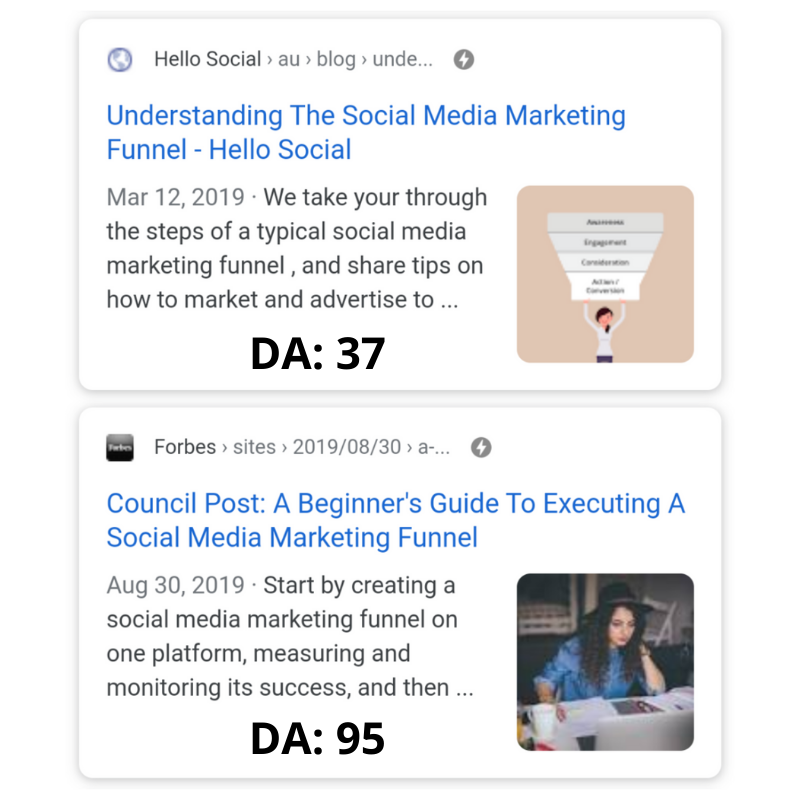
The takeaway here might be cliche (“Write quality content!”) but it rings true. Long-form, example-heavy B2B blog content is likely to gather links and score better rankings regardless of name recognition or DA.
Ready to outrank your competitors’ B2B blog content?
To wrap things up, let’s quickly recap the signs of content that you can potentially beat as a B2B writer:
- No original images, screenshots or embeds
- A lack of subheaders or paragraph breaks
- No keywords present in a post’s title, subheaders or meta description
- Low word count (a few hundred words)
- Outdated information, statistics or examples
- A lack of name recognition and/or low domain authority
Just by making sure your own B2B blog content doesn’t tick these boxes, you’re already ahead of the curve.
As a caveat, remember that ranking for keywords can be complicated.
The point of this post isn’t to guarantee better rankings, but rather to ensure that your content is better poised to gather links and be seen as authoritative.
And if you’re frustrated by low-quality posts outranking your own, don’t get mad.
Write something better instead.
Did I miss anything? Disagree with any of these points? Looking for advice on B2B writing? Feel free to hit me up (or yell at me) on Twitter (@brentwrites).
This post was last updated on 1/15/2020.
Leave a Reply